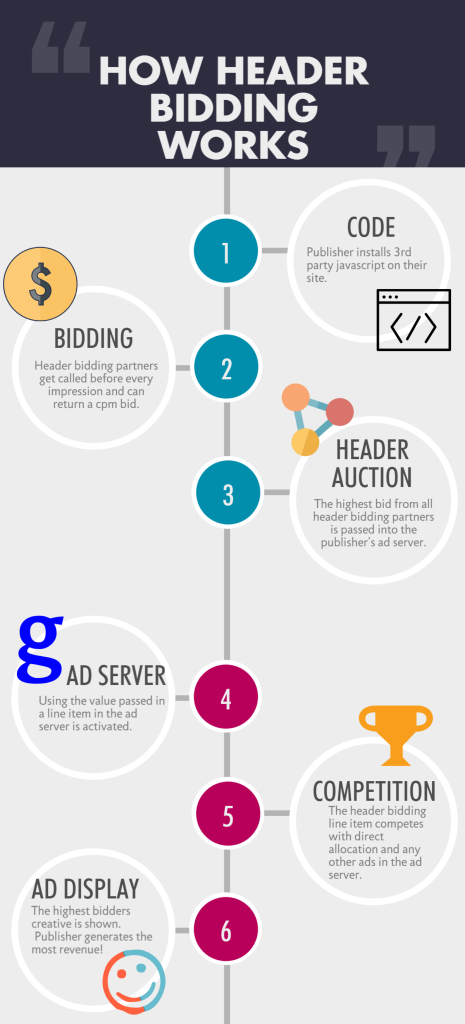What is Header Bidding?
Header bidding – also known as pre-bidding, yield
management and tagless integration – which is a bit of a misnomer as tags are required! – is an automatic way of offering your site’s inventory to several ad exchanges simultaneously. The idea is to bump up the ad yield by allowing multiple ad providers to compete for the same inventory at the same time. This increases competition and pushes up prices paid for the ad space. It allows a publisher to accept a bid from an ad exchange that beats any directly sold impression.

Benefits of Header Bidding
Before header bidding became an option, the traditional ‘waterfall’ made impressions available on a descending order of sales channels, according to the perceived value of these channels to the buyer. This has always been seen by publishers as inefficient and artificially dampening yields.
Since the inception of ad exchanges and programmatic selling, Publishers, unless selling direct, have had little alternative but to accept this arrangement, despite it artificially limiting their revenue.

To lift these restrictions, sellers are turning to a technology, which despite being around since 2009, seems to be gaining in popularity recently.
It is quite simple to enable – publishers put a piece of code in the header of their pages, allowing advertisers, or their agents, to submit bids in advance of the call to the ad server. This means that more than one, and often several, demand sources can compete simultaneously, rather in the old sequential or ‘waterfall’ manner, hiking up yields for publishers.
It brings the marketplace closer to being a unified system in which demand is presented in one place – making competition more intense by allowing the market to find the true value of available inventory on an almost real-time basis.
Header bidding can increase the income from a publisher’s inventory. It allows inventory to be offered on a ‘per-impression’ basis, giving publishers better insights into the value of their ad space. You can think of it like the closed bid system in real estate. Interested parties submit their bids before a certain time and the seller gets to see them all before choosing which one to accept.
Setting up header bidding
Here’s the science bit:
Header bidding is implemented by javascript – an example is Prebid.js – a free, open source javascript framework that is compatible with all major bidders and ad servers. There are many others of course like pubfood.org
It can be understood as a set of steps – see the diagram and explanation below:

1. User requests a website
2. Header tag script redirects user to one or many SSPs (or DSPs, or Exchanges)
3. User calls one or many SSPs in parallel
4. SSPs conduct auction with DSPs and internal network demand
5. DSPs respond with bids
6. SSP determines winning bid value and returns to User
7. User passes bid value into ad request and calls Publisher Ad Server
8. Ad server determines final line item to serve and redirects User to Marketer Ad Server
9. User calls Marketer Ad Server
10. Marketer Ad Server returns final creative
11. User calls trackback to SSP
When to do header bidding
All this happens very quickly but does add more ad latency to your ad serving, and potentially to your page loading speed. This should be monitored as page speed can have a significant impact on user experience metrics and therefore rankings. So there is a balance to be struck between increasing yield and fewer people seeing the ads due to potentially slower load times.
You can avoid this becoming a major issue by setting a specific timeout limit to your header bidding and shutting off the option to slower bidders.
Carefully managed header bidding can actually reduce latency by eradicating passback wait times and long ‘daisy-chain’ set ups, which inherently increase latency, but which are difficult to measure. So not all bad news, but it’s always good to test to see if the changes promote your monetization and growth strategies. Javascript does add to load times so whether it remains as popular with the inception of Accelerated Mobile Pages (Google AMP) and Facebook Instant Articles only time will tell.
Should I do it?
Maybe. Header bidding, despite being a relatively old technology does seem to offer yield benefits. When managed carefully it can wring out more ad income. But it does carry with it the potential for increased load times and might negatively impact user experience that could put visitors off and reduce ad impressions. As always, testing is important and trying out header bidding should be done in a measured way. It should also be considered alongside other proven improvement techniques like
As always, testing is important and trying out header bidding should be done in a measured way. It should also be considered alongside other proven improvement techniques like layout and ad testing, ensuring your site is mobile-friendly, available via an app and of course providing relevant and engaging content.



